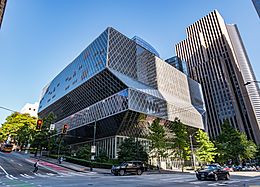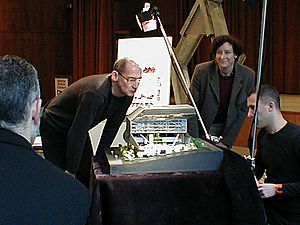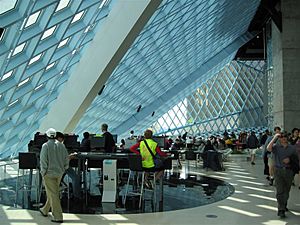Seattle Central Library facts for kids
Quick facts for kids Seattle Central Library |
|
|---|---|

Seattle Central Library in 2019
|
|
| General information | |
| Type | Public Library |
| Location | 1000 Fourth Avenue Seattle, Washington, U.S. |
| Coordinates | 47°36′24″N 122°19′57″W / 47.606699°N 122.332503°W |
| Construction started | 2002 |
| Completed | 2004 |
| Opening | May 23, 2004 |
| Cost | $165.9 million |
| Owner | Seattle Public Library |
| Height | |
| Architectural | 196 ft (60 m) |
| Roof | 185.01 ft (56.39 m) |
| Technical details | |
| Floor count | 11 |
| Floor area | 362,987 sq ft (33,700 m2) |
| Design and construction | |
| Architect | LMN Architects/Office for Metropolitan Architecture |
| Developer | Seattle Public Library |
| Structural engineer | Magnusson Klemencic Associates with Arup Group Limited |
| Main contractor | Hoffman Construction Company |
The Seattle Central Library is the main library of the Seattle Public Library system. It is a very unique and modern building. This 11-story building is made of glass and steel. It stands 185 feet (56.9 meters) tall in downtown Seattle, Washington. The library first opened its doors on May 23, 2004.
Famous architects Rem Koolhaas and Joshua Prince-Ramus helped design it. They worked with other companies like Magnusson Klemencic Associates and Arup. Arup also helped with things like plumbing, electricity, and safety systems. Hoffman Construction Company built the library.
This large public library is about 362,987 square feet (33,722 square meters). It can hold about 1.5 million books and other items. There are also over 400 computers for the public to use. The library even has underground parking for 143 cars. More than two million people visited the library in its first year!
The Seattle Central Library is on the same spot as two older libraries. This block is between Fourth and Fifth Avenues and Madison and Spring Streets. The building looks very striking. It has several "floating platforms" that seem to be wrapped in a steel net around glass walls. People started taking tours of the building's architecture in June 2004.
In 2007, the American Institute of Architects listed it as one of Americans' 150 favorite structures. It was ranked #108. Only two places in Seattle made this list. The other was T-Mobile Park, a baseball stadium.
Contents
History of the Library Building
There has been a library in downtown Seattle since 1891. But for many years, the library did not have its own building. It moved from place to place often.
The First Permanent Library
The first permanent library building was the Seattle Carnegie Library. It opened in 1906 at Fourth Avenue and Madison Street. This building had a beautiful Beaux-Arts design. Andrew Carnegie, a wealthy businessman, gave $200,000 to build it. He also helped build five other libraries in Seattle.
The Carnegie Library was 55,000 square feet (5,100 square meters). An addition was built in 1946. But as Seattle grew, the library became too small. The city's population had almost doubled since the library first opened.
The Second Library Building
A second, larger library was built on the same site in 1960. This new building was five stories tall and 206,000 square feet (19,100 square meters). It had a modern, international style. It also had new features like drive-thru service for books.
Artist George Tsutakawa created a sculpture called "Fountain of Wisdom" for this library. It was first on the Fifth Avenue side. In 1972, the fourth floor was opened to the public. This floor was for arts and music recordings.
By the late 1990s, this library also became too small. Two-thirds of its materials were kept in storage. People could not easily access them. Also, officials worried about the building's safety during earthquakes.
Building the Current Library

The Seattle Central Library we see today is the third library building on this city block. Voters in Seattle approved a $196.4 million plan in 1998. This money was for the new Central Library and other library projects. Bill Gates of Microsoft also donated $20 million.
Rem Koolhaas and Joshua Prince-Ramus from the Dutch company Office for Metropolitan Architecture (OMA) were the main architects. They worked with a Seattle company called LMN Architects. Joshua Prince-Ramus was in charge of the project.
OMA was not originally asked to compete for the project. But Ramus, who used to live in Seattle, found out about a public meeting. He flew in, and OMA ended up winning the design job! Deborah Jacobs, the Chief Librarian, led the project from the library's side.
Design of the Library
The architects wanted the new Central Library to celebrate books. They believed that even in the "digital age," people still love books printed on paper. The 11-story library can hold over 1.5 million books. This is much more than the old library's 900,000 books.
The architects also wanted the library to feel welcoming, not old-fashioned. They found that many people thought libraries were boring. So, they designed a building that would be exciting and inviting.
The building looks unusual from the outside. But the architects designed it by thinking about what the library needed to do. They let the functions of the building shape its look.
Special Features Inside
One major part of the building is the "Books Spiral." This area shows the library's nonfiction collection. It keeps all the books in the Dewey Decimal System order without breaking them up onto different floors. The collection spirals up through four stories on a continuous set of shelves. This means you can walk through the whole collection without using stairs or going to another part of the building.
Other cool features inside include:
- The Microsoft Auditorium on the ground floor.
- The "Living Room" on the third floor, a cozy space for reading.
- The Charles Simonyi Mixing Chamber, a special help desk where staff from different areas can answer questions.
- The Betty Jane Narver Reading Room on level 10, which has great views of Elliott Bay.
The library also has new technology. This includes automatic book sorting, self-checkout machines, and wireless internet for staff. There are also over 400 public computers for everyone to use.
Images for kids
See also
 In Spanish: Biblioteca Central de Seattle para niños
In Spanish: Biblioteca Central de Seattle para niños














